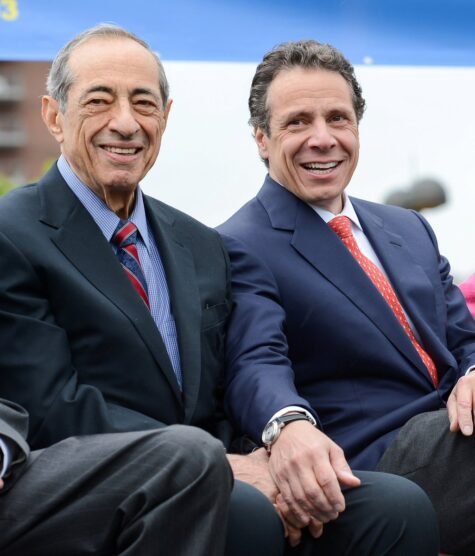
This is about Andrew and Mario Cuomo. First, Andrew: a man of contradictions.With the dangers of nuclear power a journalistic focus of mine for decades, I thought his role in the closing of the Indian Point nuclear power plants 25 miles north of New York City an act of courage. He faced fierce nuclear industry opposition. The two-plant facility shut down this past April.But while engaged in seeking to have Indian Point closed, Andrew Cuomo pushed for a $7.6 billion state bailout to allow four aging nuclear power plants near Syracuse and also Rochester in upstate New York to keep operating. Their owners said they had become uneconomic to run. The Cuomo 2016 bailout was linked to a Clean Energy Standard he advanced under which much of the electricity used in the state would come from “clean and renewable energy sources.” Under the $7.6 billion bailout, the four nuclear plants were considered as producing “clean and renewable” electricity – despite green energy advocates saying this was false.Among those challenging the scheme was the Alliance for a Green Economy, based in Syracuse with a chapter in New York City, whose Program Director Jessica Azulay declared, “Without these subsidies, nuclear plants cannot compete with renewable energy … Every dollar spent on nuclear subsidies is a dollar out of the pocket of New York’s electricity consumers.”Residential ratepayers and businesses, including people and businesses on Fire Island and other entities including schools and governments in New York State, have since been paying, and for years will continue to have to pay an added charge on their electric bills thanks to the Andrew Cuomo nuclear bailout.Likewise, as the City & State website headlined, “Cuomo contradicts his own harassment law.” Andrew Cuomo, who will end being New York’s governor in a matter of days because of a major sexual harassment scandal, pushed for a less burdensome definition of sexual harassment in a law he signed in 2019. “It was a change that Cuomo celebrated and something he has taken credit for implementing,” noted City & State. But his actions, as determined by the New York attorney general, points to his having repeatedly violated this law and a cause he embraced.Mario Cuomo, in the case of the Shoreham nuclear power plant on Long Island, was as strong as his son was on Indian Point – but in the end left electric ratepayers on Long Island, and Fire Island, too, unnecessarily with a bill of also more than $7 billion.I first met Mario Cuomo when he pursued the Democratic nomination to run for governor in 1982. I was co-anchor of the evening news on Long Island’s then commercial TV station, WSNL-TV/67 in Smithtown, and Mario Cuomo came to be interviewed. The battle over the Shoreham plant was raging and I questioned him about it. He seemed unaware of much concerning nuclear power. After the taping, I suggested we sit down and I’d offer him a book I had written, published in 1980, “Cover Up: What You ARE NOT Supposed to Know About Nuclear Power.”In authoring the book, I felt it would be helpful to reproduce as facsimiles many government and industry documents to authenticate the facts. Mario Cuomo’s jaw dropped as he examined the documents. For example, there was the passage of a report done by Brookhaven National Laboratory on the consequences of a nuclear power plant accident declaring that “the possible size of the area of such a disaster might be equal to that of the State of Pennsylvania.”Mario Cuomo cringed seeing the reproduction of the “nuclear clause” that is still in every homeowner’s insurance policy in the U.S. which says, “This policy does not cover loss or damage caused by nuclear reaction or nuclear radiation or radioactive contamination.”This sit-down with Mario Cuomo might have been a factor in his becoming opposed to Shoreham. The key to stopping Shoreham was the Long Island Power Act of 1985. Under it, the state would create a Long Island Power Authority to replace the Long Island Lighting Company, the builder and owner of Shoreham, and close the nuclear plant. As for cost, the act provided for the state to acquire the stock of LILCO, enormously reduced because of LILCO’s nuclear adventure, or to purchase LILCO’s assets.Citizens to Replace LILCO, the organization spearheading support for the act, called for acquisition of stock, far cheaper, it emphasized, than buying LILCO’s assets. Mario Cuomo opposed that believing it too radical for Wall Street. So electric ratepayers of the new LIPA, which covers Fire Island, got stuck with a far larger debt than necessary to stop Shoreham – now $7.5 billion.Maurice Barbash, Chair of Citizens to Replace LILCO spoke painfully for years about Mario Cuomo telephoning him at his office in Babylon and, with the kind of bullying later to be closely associated with Andrew, threatening to send state auditors to look into his building business because of his group’s stance. Earlier of course Mr. Barbash had served as chairman of the Citizen Committee for a Fire Island National Seashore, was a leader in the battle to block the four-lane highway Robert Moses wanted to build the length of Fire Island and, instead, create the Fire Island National Seashore. He was the builder of Dunewood on Fire Island.Also under the act, LIPA was to have a board elected by people in its service area to set the area’s energy policy and chart its energy future. Mario Cuomo suspended that after LIPA was founded switching to having a board of trustees appointed by three officials in Albany: the Assembly speaker, Senate president and governor. Goodbye to a grassroots democratic energy process.




























